Physical Address
304 North Cardinal St.
Dorchester Center, MA 02124
Most of us think of skin as a simple, durable covering for the skeleton and internal organs. Yet skin is actually a very complex and dynamic organ consisting of many parts and appendages ( Fig. 1.1 ). The outermost layer of the epidermis, the stratum corneum, is an effective barrier to the penetration of irritants, toxins, and organisms, as well as a membrane that holds in body fluids. The remainder of the epidermis, the stratum granulosum, stratum spinosum, and stratum basale, manufactures this protective layer. Melanocytes within the epidermis are important for protection against the harmful effects of ultraviolet light, and the Langerhans cells and other dendritic cells are one of the body’s first lines of immunologic defense and play a key role in systemic and cutaneous diseases such as drug reactions and infections.
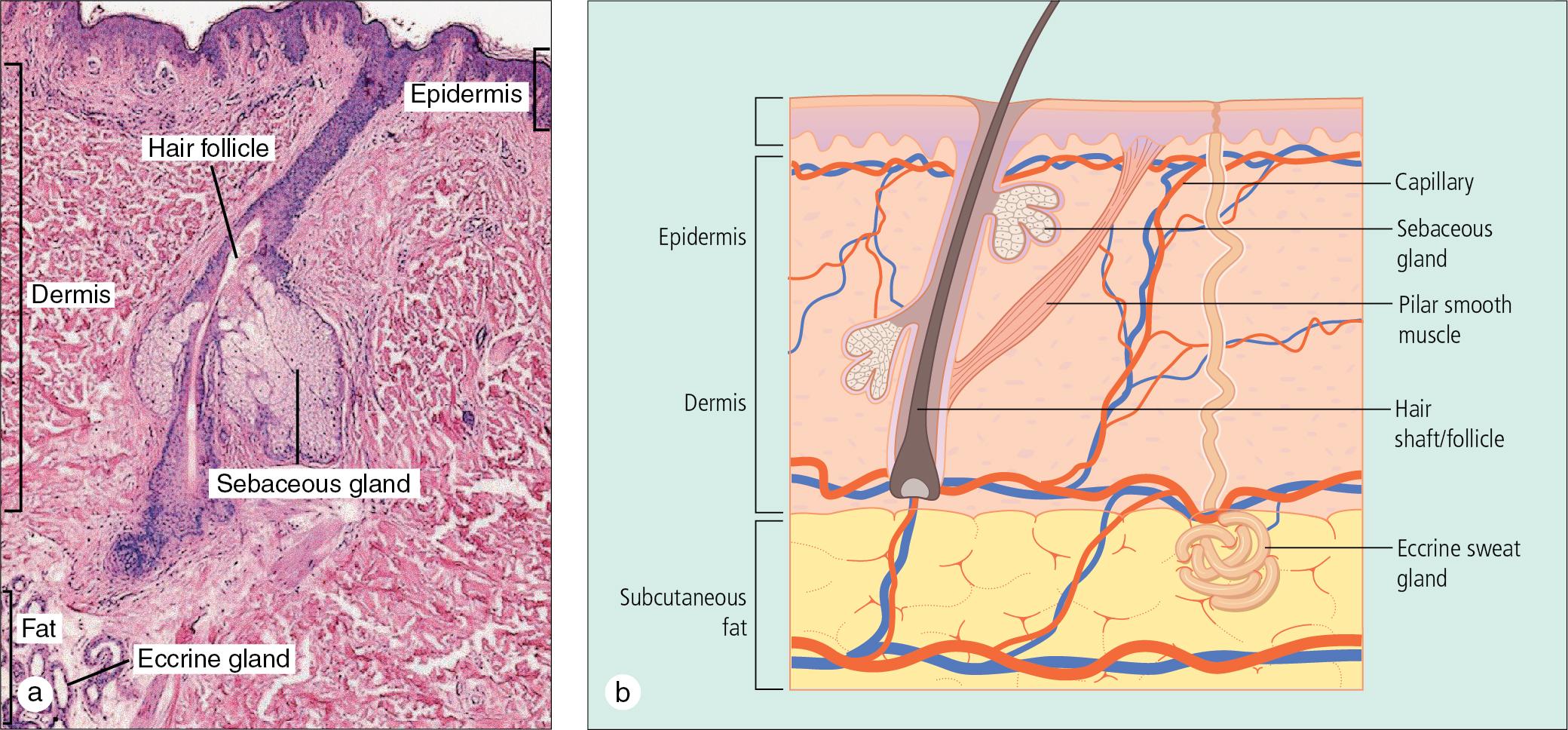
The dermis, consisting largely of fibroblasts and collagen, is a tough, leathery, mechanical barrier against cuts, bites, and bruises. Its collagenous matrix also provides structural support for a number of cutaneous appendages. Hair, which grows from follicles deep within the dermis, is important for cosmesis, as well as protection from sunlight and particulate matter. Sebaceous glands arise as an outgrowth of the hair follicles. Oil produced by these glands helps to lubricate the skin and contributes to the protective function of the epidermal barrier. The nails are specialized organs of manipulation that also protect sensitive digits. Thermoregulation of the skin is accomplished by eccrine sweat glands and changes in the cutaneous blood flow regulated by glomus cells. The skin also contains specialized receptors for heat, pain, touch, and pressure. Sensory input from these structures helps to protect the skin surface against environmental trauma. Beneath the dermis, in the subcutaneous tissue, fat is stored as a source of energy and also acts as a soft protective cushion.
The skin is the largest and most accessible and easily examined organ of the body, and it is often the organ of most frequent concern and quality of life for the patient. Therefore all practitioners should be able to recognize basic skin diseases and dermatologic clues to systemic disease.
Optimal examination of the skin is best achieved in a well-lit room. The clinician should inspect the entire skin surface, including the hair, nails, scalp, and mucous membranes. This may present particular problems in infants and teenagers, because it may be necessary to examine the skin in small segments to prevent cooling or embarrassment, respectively. Although no special equipment is required, a hand lens and side lighting are useful aids in the assessment of skin texture and small, discrete lesions. In many offices, the otoscope can be adapted for this purpose by removing the plastic speculum.
There are also a number of relatively inexpensive portable dermatoscopic devices, which can also be used to enhance the examination (also known as epiluminescence microscopy). These instruments have traditionally provided a magnified (×10) view of the skin with a nonpolarized light source, a transparent plate, and a liquid medium between the dermatoscope and the skin. This allows for a view of the superficial structures in the skin without interference from surface reflections. Dermatoscopic heads can be purchased for otoscope/ophthalmoscope handpieces, and mineral oil or alcohol gel can be applied directly to the skin lesion. Newer devices allow for toggling between nonpolarized and polarized light, which provides visualization of deeper structures in the dermis. ( Fig. 1.2 ).
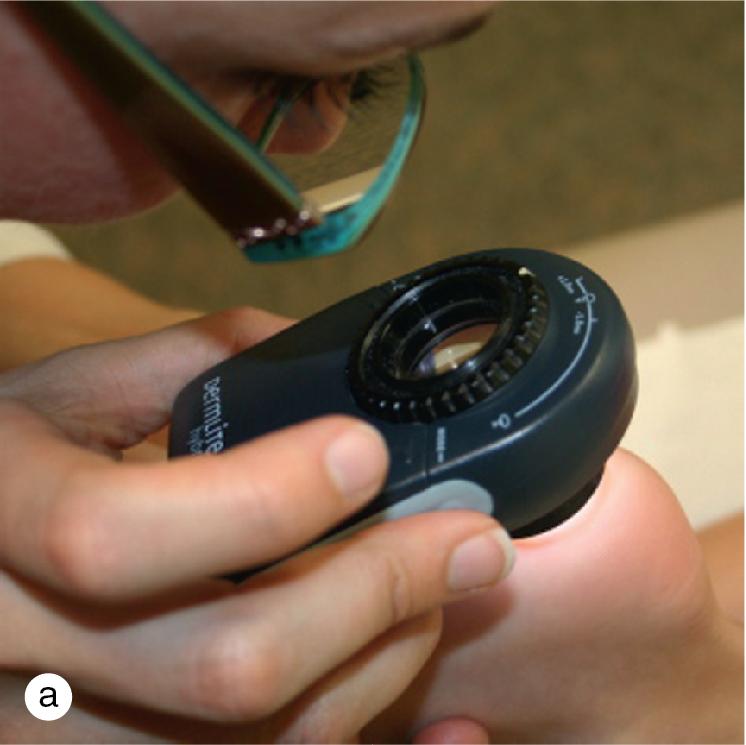
Despite the myriad of conditions affecting skin, a systematic approach to the evaluation of a rash facilitates and simplifies the process of developing a manageable differential diagnosis. After assessing the general health of a child, the practitioner should obtain a detailed history of the cutaneous symptoms, including the date of onset, inciting factors, evolution of lesions, and presence or absence of pruritus. Recent immunizations, infections, drugs, and allergies may be directly related to new rashes. The family history may suggest a hereditary or contagious process, and the clinician may need to examine other members of the family. A review of nursery records and images provided by parents and in the electronic record will help document the presence and evolution of congenital and acquired lesions.
Attention should then turn to the distribution and pattern of the rash. The distribution refers to the location of the skin findings, while the pattern defines a specific anatomic or physiologic arrangement. For example, the distribution of a rash may include the extremities, face, or trunk, while the pattern could be flexural or intertriginous areas ( Fig. 1.3 a). Other common patterns include sun-exposed sites, acrodermatitis (predilection for the distal extremities), pityriasis rosea (truncal, following the skin cleavage lines), clothing-protected sites, acneiform rashes, lines of Blaschko, and segmental lesions ( Fig. 1.3 b–h).
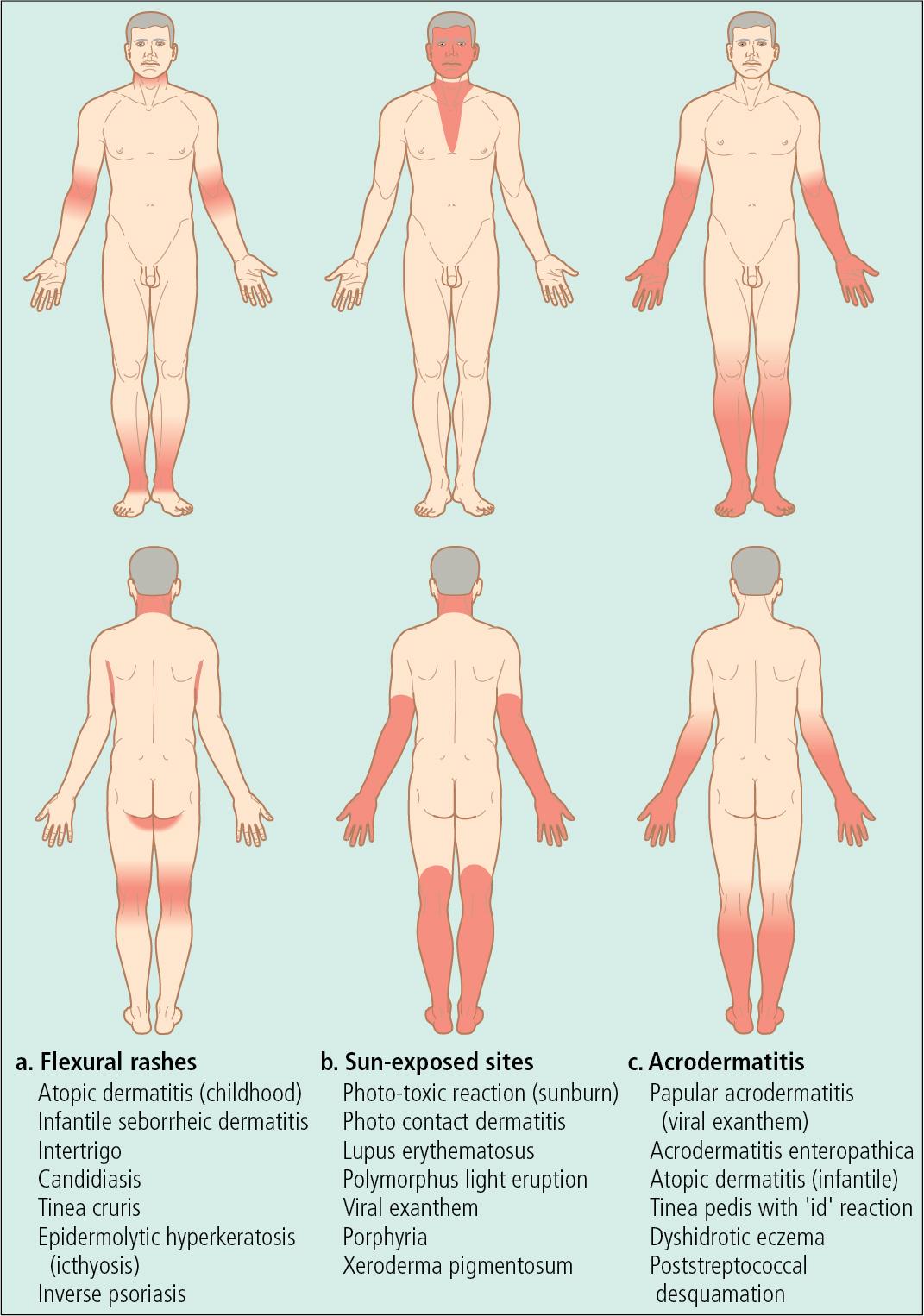
Next, the clinician should consider the local organization and configuration of the lesions, defining the relationship of primary and secondary lesions to one another in a given location ( Table 1.1 ) and the shape of the lesions. Are the lesions diffusely scattered or clustered (herpetiform)? Are they dermatomal, linear, serpiginous, circular, annular, or reticulated?
 |
 |
 |
 |
 |
 |
 |
 |
|---|---|---|---|---|---|---|---|
| Linear | Dermatomal | Serpiginous | Annular | Herpetiform | Reticulated | Filiform (Thread-like) | Geographic |
|
|
|
|
|
|
|
|
The depth of the lesions in the skin, as noted by both observation and palpation, may also give further clues ( Table 1.2 ). Disruption of the normal skin markings by scale, papules, vesicles, or pustules points to the involvement of the epidermis. Alterations in skin color alone can occur in epidermal and dermal processes. In disorders of pigmentation, the color of the pigment may suggest the anatomic depth of the lesion. Shades of brown are present in flat junctional nevi, lentigines, and café-au-lait spots, where the increased pigment resides in the epidermis or superficial dermis. In Mongolian spots and nevus of Ota, the Tyndall effect results in bluish-green to gray macules from melanin uniformly distributed in the mid-dermis. If the epidermal markings are normal but the lesion is elevated, the disorder usually involves the dermis. Dermal lesions have well-demarcated firm borders. Nodules and tumors deep in the dermis or subcutaneous tissue can distort the surface markings, which are otherwise intact. Some deep-seated lesions can only be appreciated by careful palpation.
| Cutaneous Structure | Physical Findings | Specific Skin Disorder | |
|---|---|---|---|
| Epidermis |
|
|
 |
| Epidermis + dermis |
|
|
 |
| Dermis |
|
|
 |
| Subcutaneous tissue |
|
|
 |
Lesion color can provide important clues for diagnosis and the pathophysiology of the underlying process ( Table 1.3 ). Brown, blue, gray, bronze, and black lesions are associated with disorders that alter normal pigmentation, while white lesions may be associated with loss of normal pigmentation or the accumulation of scale, crust, or exudates. Red and blue lesions are associated with inflammatory and vascular processes. Nonblanching blue or purple lesions should suggest the presence of purpura. Yellow lesions occur when the skin is infiltrated with inflammatory or tumor cells containing lipid. Other pigments from topical agents (e.g. silver, gold), oral medications (e.g. minocycline, amiodarone), foreign bodies (e.g. asphalt, tattoo pigments), and infectious agents (e.g. Pseudomonas species, Corynebacterium species) may impart specific colors to cutaneous lesions.
 |
 |
 |
 |
 |
 |
 |
 |
|---|---|---|---|---|---|---|---|
| Red | Purple | Brown | Gray | Blue | Bronze | Green | Yellow |
| Inflammatory disorders, such as eczema, psoriasis, urticaria, erythema chronicum migrans, and other figurate erythemas | Purpura, vascular malformations, hemangiomas, hematoma | Pigmented nevus, post-inflammatory hyperpigmentation, lentigo, ephiled (freckle), café-au-lait spot, epidermal nevus | Mongolian spot, graphite tattoo, nevus of Ota | Tattoo, vascular malformation, hemangiomas, blue nevus, Mongolian spot | Progressive-pigmented purpuric dermatosis, resolving hematoma, phyto-photodermatitis | Tattoo, pseudomonas infection, deposition of minocycline, Mongolian spot, resolving hematoma | Xantho-granuloma, xanthoma, sebaceous hyperplasia, epidermal inclusion cyst |
Finally, the clinician may develop a differential diagnosis using the morphology of the cutaneous lesions. Primary lesions (macules, papules, plaques, vesicles, bullae, pustules, wheals, nodules, and tumors) arise de novo in the skin ( Fig. 1.4 ). Secondary lesions (scale, crust, erosions, ulcers, scars with atrophy and/or fibrosis, excoriations, and fissures) evolve from primary lesions or result from scratching of primary lesions by the patient ( Fig. 1.5 ).
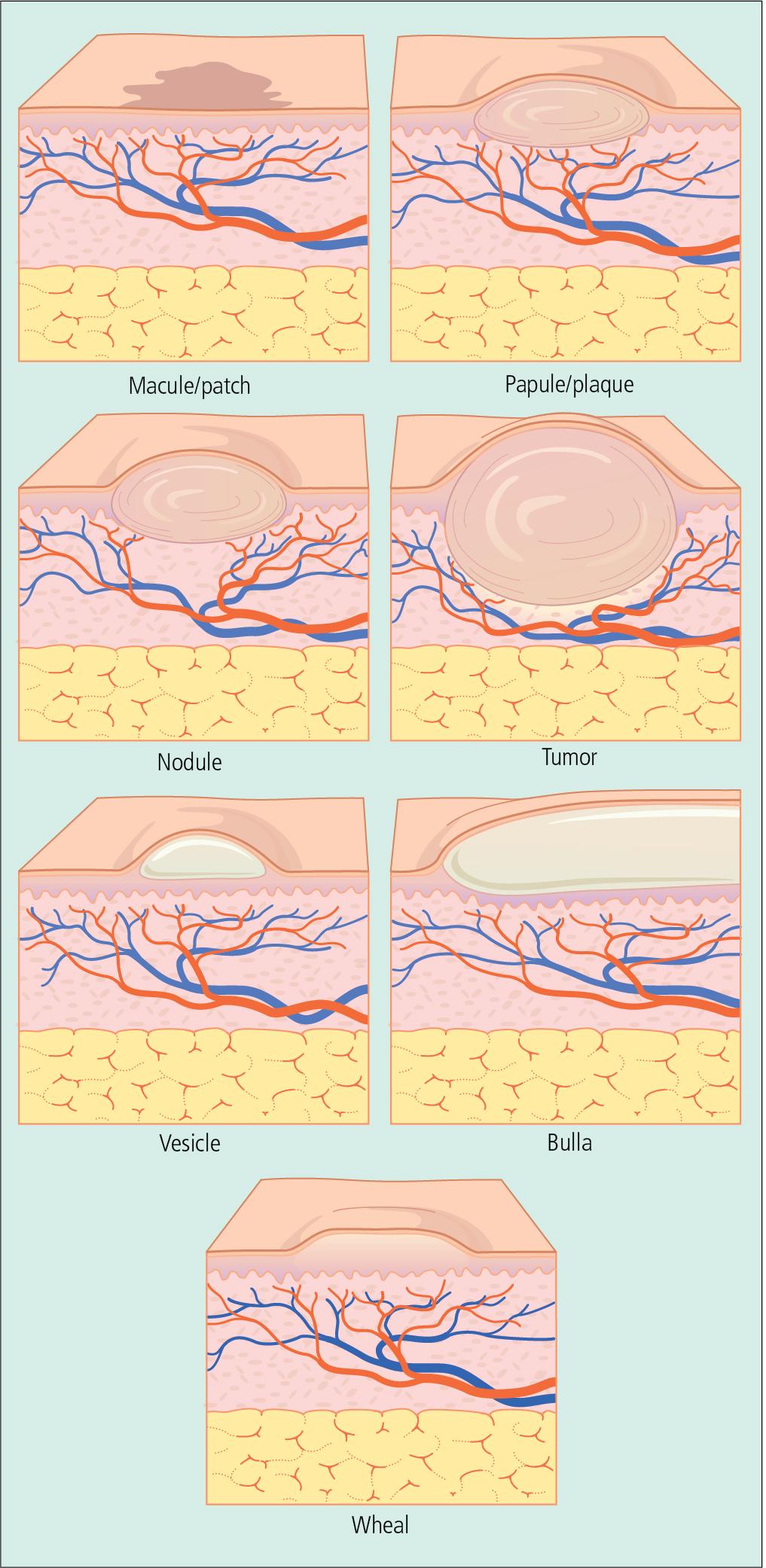
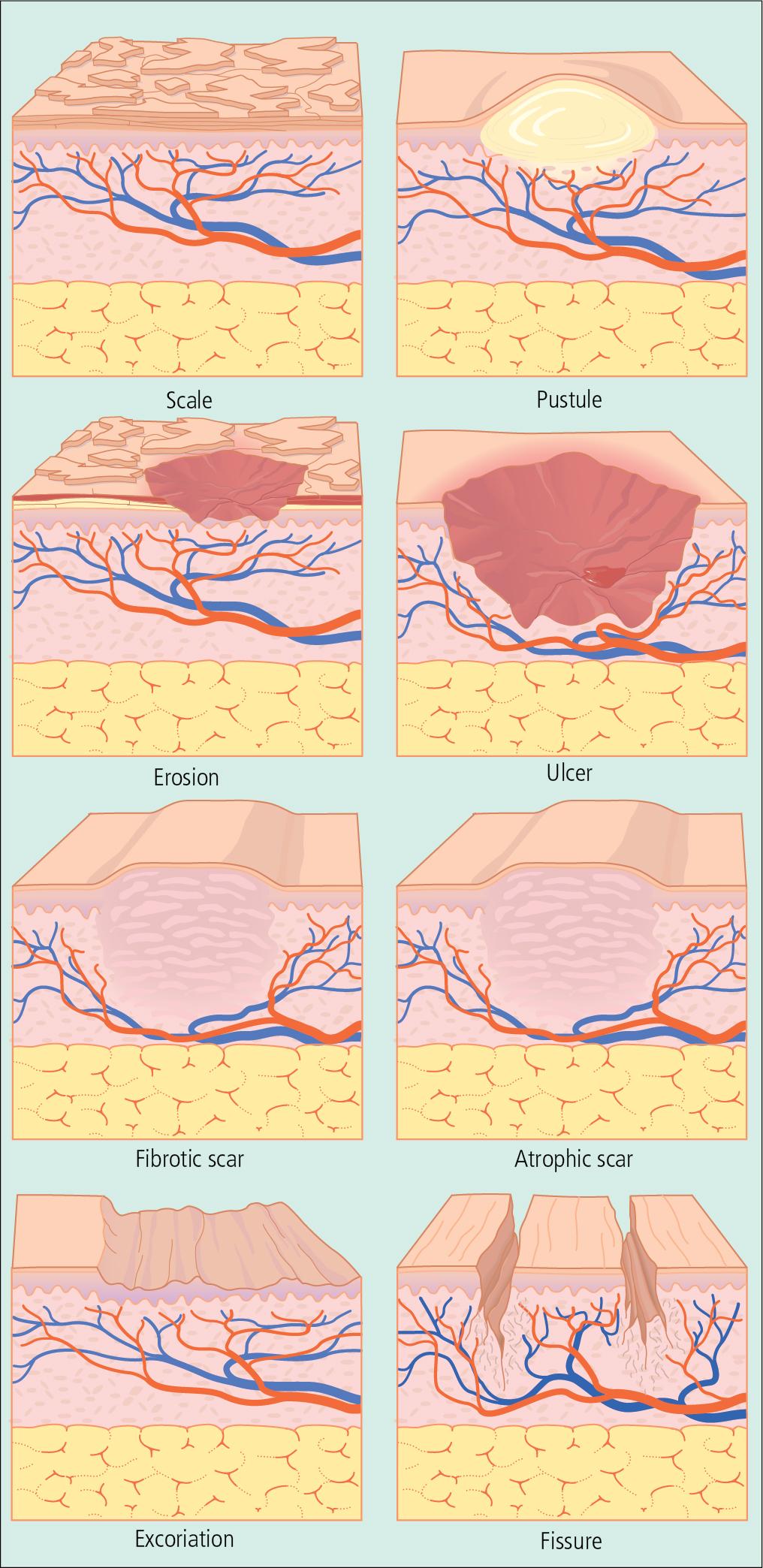
The practitioner who becomes comfortable with dermatology will integrate all of these approaches into their evaluation of a child with a skin problem. This will be reflected in the clinically focused format of this text.
Each chapter will finish with an algorithm that summarizes the material in a differential diagnostic flow pattern. The limited bibliography includes comprehensive, historically significant, and/or well-organized reviews of the subject. Readers may also find some of the texts and online further reading listed at the end of this chapter useful.
There are a number of rapid, bedside diagnostic procedures in dermatology. One of the most useful techniques is a wet mount of skin scrapings for microscopic examination ( Fig. 1.6 ). Potassium hydroxide (KOH) 20% is used to change the optic properties of skin samples and make scales more transparent. The technique requires practice and patience.
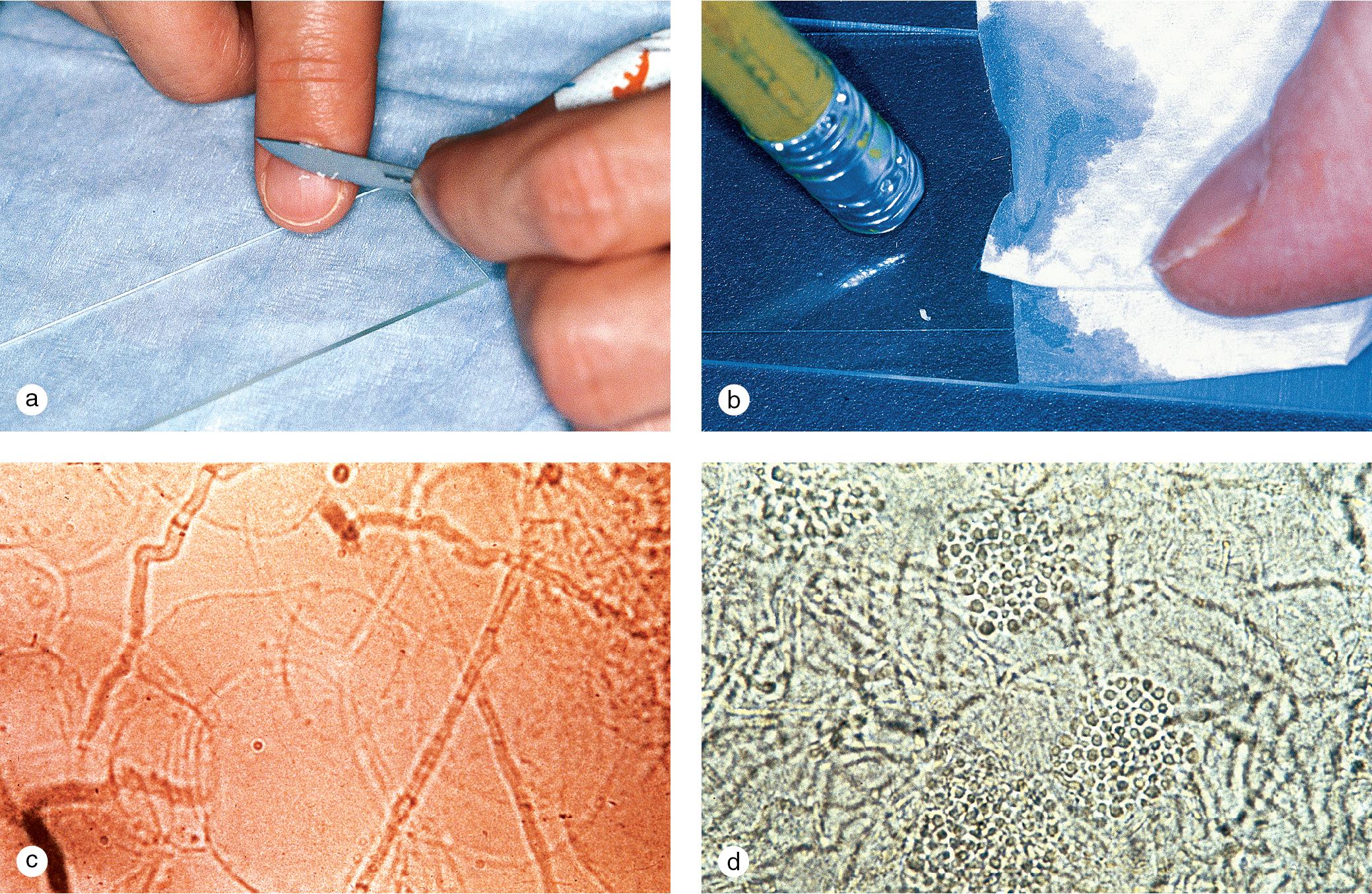
The first step is to obtain the material by scraping loose scales at the margin of a lesion, nail parings, subungual debris, or the small, pearly globules from a molluscum body. Short residual hair stubs (black dots in tinea capitis) may also be painlessly shaved off the scalp with a #15 blade. Scale is placed on the slide and moved to the center with a cover slip. One or two drops of KOH are added and gently warmed with a match or the microscope light. Boiling the specimen will introduce artifacts and should be avoided, so sitting the specimen aside for 5 min is an alternative to gentle heating. Excess KOH can be removed with a paper towel applied to the edge of the cover slip. Thick specimens may be more easily viewed after gentle but firm pressure is applied to the cover slip with a pencil eraser. Thick scale will also dissolve after being set aside for 15–20 min.
View the preparation under a microscope, with the condenser and light at low levels to maximize contrast, and with the objective at ×10. Focus up and down as the entire slide is rapidly scanned. True hyphae are long branching green hyaline rods of uniform width that cross the borders of epidermal cells. They often contain septae. False positives may be vegetative fibers, cell borders, or other artifacts. Yeast infections show budding yeast and pseudohyphae. Molluscum bodies are oval discs that have homogeneous cytoplasm and are slightly larger than keratinocytes. In hair fragments, the fungi appear as small, round spores packed within or surrounding the hair shaft (see Fig. 8.19 e in Chapter 8 ). Hyphae are only rarely seen on the hair.
A skin scraping showing a mite, its egg, or feces is necessary to diagnose infestation with Acarus scabiei because many other skin rashes resemble scabies clinically ( Fig. 1.7 ). The most important factor for obtaining a successful scraping is the choice of site. Burrows and papules, which are most likely to harbor the mite, are commonly located on the wrists, fingers, and elbows. In infants, primary lesions may also be found on the trunk, palms, and soles. A fresh burrow can be identified as a 5–10 mm elongated papule, with a vesicle or pustule at one end. A small, dark spot resembling a fleck of pepper may be seen in the vesicle. This spot is the mite, and it can be lifted out of its burrow with a needle or the point of a scalpel. Usually, it is best to hold the skin taut between the thumb and index finger while vigorously scraping the burrow. Although this may induce a small amount of bleeding, if performed with multiple, short, rapid strokes, it is usually painless. A drop of mineral oil should be applied to the skin before scraping to ensure adherence of the scrapings to the blade. The scrapings are then placed on the slide, another drop of mineral oil is added, and a cover slip is applied. Gentle pressure with a pencil eraser may be used to flatten thick specimens.
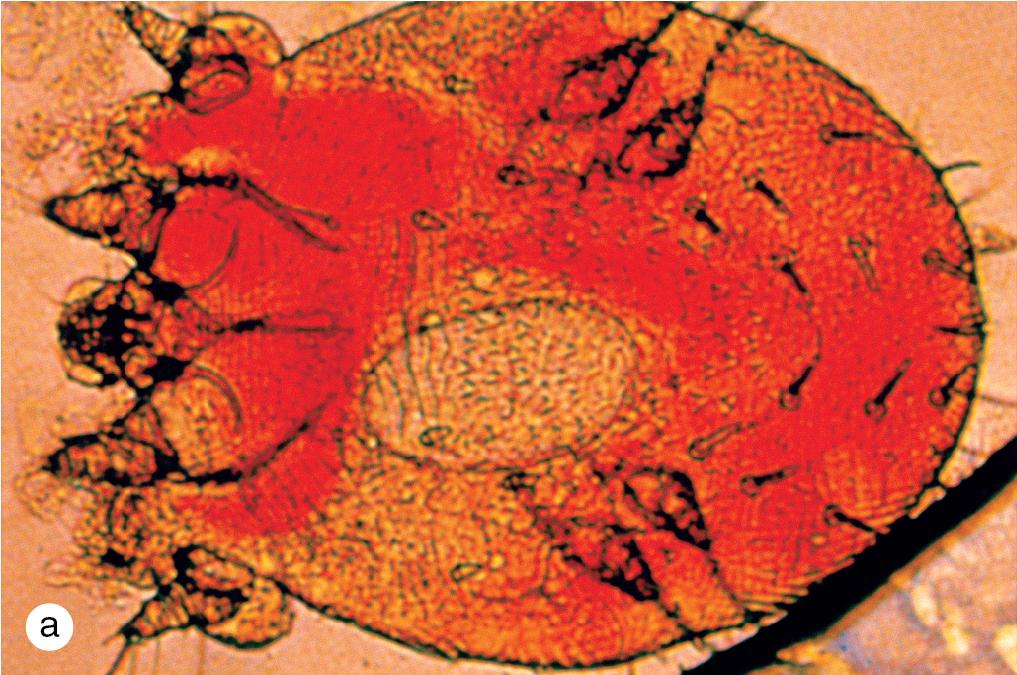
Mites are eight-legged arachnids easily identified with the scanning power of the microscope. Care must be taken to focus through thick areas of skin scrapings so as not to miss any camouflaged mites. The presence of eggs (smooth ovals, approximately one half the size of an adult mite) or feces (brown pellets, often seen in clusters) are also diagnostic. If eggs or feces are found first, perusal of the entire slide usually reveals the adult mite.
The dermatoscope can also be used to visualize the female mite whose mouth parts appear as an elongated triangle-shaped spot referred to as a delta sign.
Lice are six-legged insects visible to the unaided eye that are commonly found on the scalp ( Fig. 1.8 ), eyelashes, and pubic areas. Pubic lice are short and broad, with claws spaced far apart for grasping the sparse hairs on the trunk, pubic area, and eyelashes, whereas scalp lice are long and thin, with claws closer together to grasp the denser hairs found on the head. The lice are best identified close to the skin, where their eggs are more numerous and more obvious. Diagnosis can be made by identifying the louse, or by plucking hairs and confirming the presence of its eggs or “nits” by microscopic examination. A dermatoscope or magnifying glass can also be used for confirmation of lice infestation.
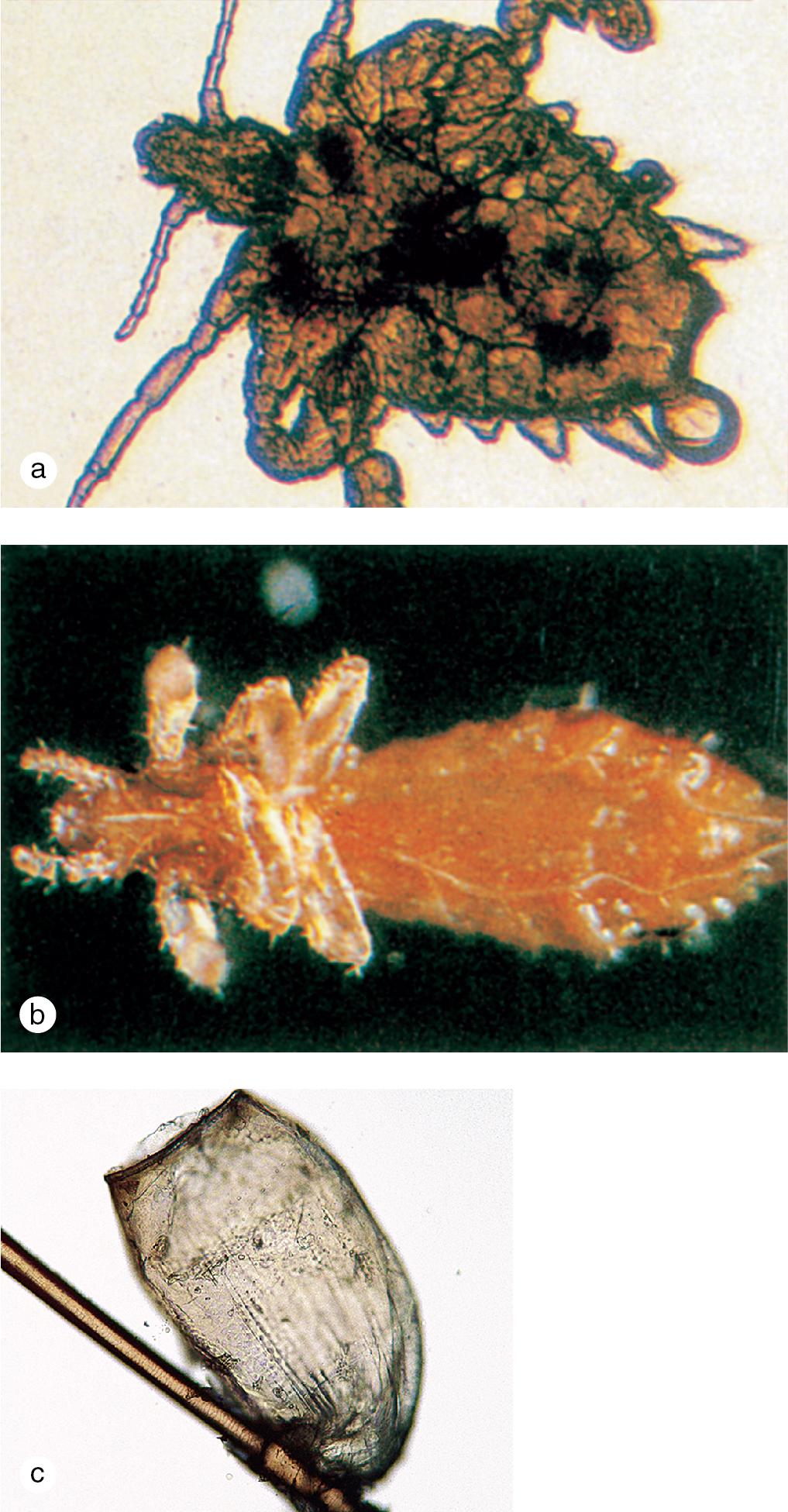
The Tzanck smear is an important diagnostic tool in the evaluation of blistering diseases. It is most commonly used to distinguish viral diseases, such as herpes simplex, varicella, and herpes zoster, from nonviral disorders ( Fig. 1.9 ). It is important to note that Tzanck smears from vesicles of vaccinia and smallpox do not demonstrate multinucleated giant cells. The smear is obtained by removing the “roof” of the blister with a curved scalpel blade or scissors, and scraping the base to obtain the moist, cloudy debris. The material is then spread onto a glass slide, air dried, and stained with Giemsa or Wright stain. The diagnostic finding of viral blisters is the multinucleated giant cell. The giant cell is a syncytium of epidermal cells, with multiple overlapping nuclei; it is much larger than other inflammatory cells. A giant cell may be mistaken for multiple epidermal cells piled on top of each other. If a microscope and stain are available, the Tzanck smear can be used for rapid confirmation of the clinical suspicion of infection, while more sensitive studies like polymerase chain reaction are pending.
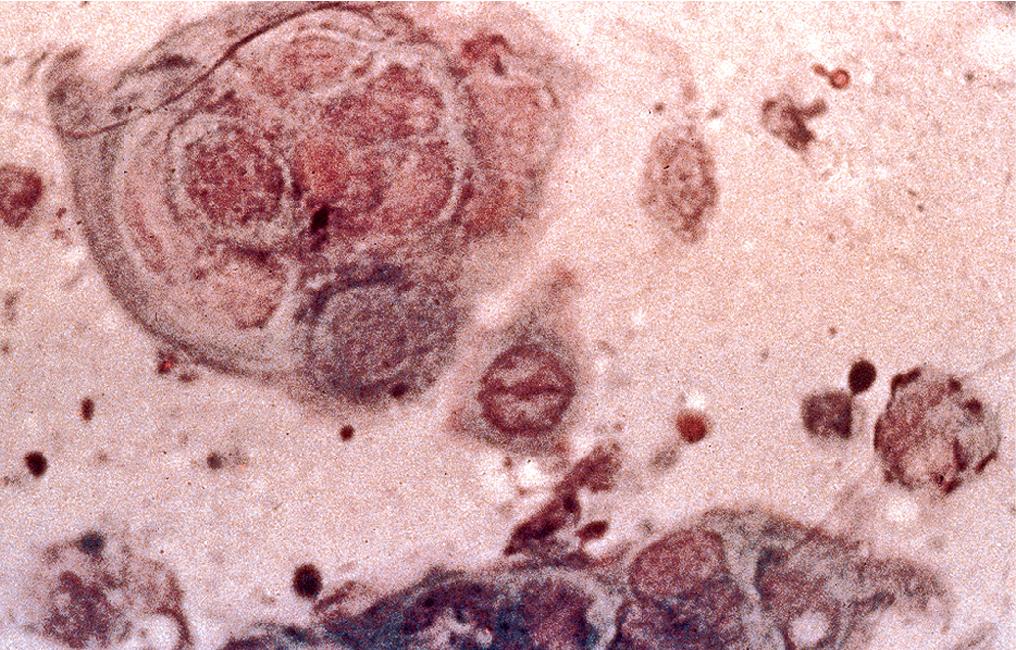
Wood light is an ultraviolet source that emits at a wavelength of 365 nm. Formerly, its most common use was in screening patients with alopecia for tinea capitis, as the most common causative organisms, Microsporum audouinii and other Microsporum species, were easily identified by blue-green fluorescence under Wood light. However, today in North America, Trichophyton species are the most common fungi associated with tinea capitis, but it does not fluoresce. In the United States, fewer than 10% of cases are caused by M. canis and other Microsporum species. In Europe, Africa, and Asia, organisms that cause ectothrix scalp infection and which fluoresce include M. ferrugineum, M. audouinii, and M. canis.
Wood light is still of value in diagnosing a number of other diseases. Erythrasma is a superficial bacterial infection of moist skin in the groin, axilla, and toe webs. It appears as a brown or red flat plaque and is caused by a Corynebacterium that excretes a pigment that contains a porphyrin. This pigment fluoresces coral red or pink under Wood light. Tinea versicolor, a superficial fungal infection with hypopigmented macules and plaques on the trunk, also fluoresces under Wood light with a green-yellow color. Pseudomonas infection of the toe web space and colonization of the skin in burn patients will fluoresce yellow-green. Patients with porphyria cutanea tarda excrete uroporphyrins in their urine, and examination of a urine specimen will show an orange-yellow fluorescence. Adequate blood levels of tetracycline produce yellow fluorescence in the opening of hair follicles, while lack of fluorescence indicates poor intestinal absorption or poor patient compliance. Positive fluorescence in the skin is diagnostically useful, but many of the pigments that fluoresce are water soluble and readily removed by swimming or bathing.
Wood light also emits purple light in the visible spectrum. This wavelength can be used to accentuate subtle changes in pigmentation. The purple light is absorbed by melanin in the epidermis, and variably reflected by patches of hypopigmentation and depigmentation. It can be helpful to distinguish increased pigmentation in the epidermis that will be enhanced by the purple light from increased pigmentation in the dermis that does not enhance. Purple light may be particularly useful in evaluating light-pigmented individuals with vitiligo or ash leaf macules (congenital hypopigmented macules).
Become a Clinical Tree membership for Full access and enjoy Unlimited articles
If you are a member. Log in here